The next time you’re in a library, Internet cafe or hotel lobby, look around: There’s a good chance you’ll see more than a few people using ultra-small form factor PCs — computers that have been shrunk down to as little as one-fiftieth the size of a typical tower PC.
While many models are designed for consumers, these tiny computers are making their way into the business world, gracing reception areas, meeting rooms and even workers’ cubicles. Some are no bigger than a paperback book, but unlike their underpowered predecessors, today’s models provide enough performance for typical business tasks and can even support streaming high-definition video smoothly.
At the same time, they consume only about 25 per cent as much electricity as a typical tower PC does, according to the Environmental Protection Agency (see PDF). That can add up to solid savings, with some of these tiny PCs saving more than $25 on electricity over a year of 10-hour workdays.
But for many businesses, the real payoff is that these computers are so small that they can be stashed in out-of-the-way places, such as a desk drawer, underneath a table or on the back of a monitor.
I put three of these tiny computers to the test to see how they stack up, but before we get to the reviews, let’s look at how these PCs are being used in business today.
In classrooms, boardrooms and beyond
Although these tiny PCs account for less than 1 per cent of total computer sales, their sales are growing rapidly, says Stephen Baker, an analyst at market research firm NPD Group. “These systems are perfect for uses where you’re squeezed into a tight space, want to save on power or just not see a clunky tower case. They pack a lot of power in a small package,” he says.
Tiny PCs are particularly apt for organizations that require lots of basic computers but are short on space. A case in point is the Greenfield-Central Community School Corporation in Greenfield, Ind., a school district with eight facilities and 4,700 students. In December 2009, the district purchased 300 cigar-box-size Acer Veriton N260G systems for classrooms in its recently renovated Greenfield-Central High School. The district added 400 more this April for its new junior high school and now has a total of 700 tiny PCs.
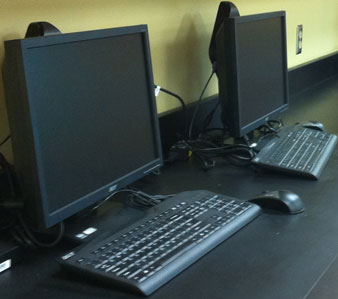
Small Acer Veriton N260Gs cling to the back of monitors at a school in Greenfield, Ind.
The devices are used in everything from biology labs to English classrooms. “They’re the equivalent of traditional PCs but smaller and use less power,” explains Greg Thompson, the district’s technology operations director. Over the course of a year, Thompson figures the district saves as much as $10,000 a year in electricity bills. “A big bonus is that they run cooler and quieter,” he adds.
RevelDigital in Fargo, N.D. sells digital signs — computer-driven displays that companies can use to show advertising, Web content, live video streams and more. The company has assembled 1,500 digital signs using ViewSonic VOT132 PC Minis and its own software, which feeds data to the display. Behind the scenes, the tiny computer does the heavy data lifting for the sign’s text, video and special effects.
“The VOT132 is about as small as a PC gets these days,” says Theodore Rosenbaum, Revel’s CEO. “It lets us put it in a lot of places where a traditional PC won’t fit, like behind a wall.” Revel is evaluating the newer VOT125, which is reviewed in this story.
Some of RevelDigital’s signs are used as digital menu boards in restaurants, where the offerings can be changed at a moment’s notice if, say, the chef changes his mind or a special sells out. Others relay vital information to workers on oil rigs or play digital advertisements to travelers in train stations.
Putting tiny PCs to the test
As small and efficient as these petite PCs are, some companies may be reluctant to spend money on them. While some models are inexpensive, others can cost as much as two lower-priced desktop PCs. What’s more, they often have limited configuration options and cramped interiors; you can change memory modules or the hard drive, but you can’t pop in a PCI card or a new graphics processor.
To see if these trade-offs are worth it, I gathered three Windows 7-based micro PCs that are ready for business: Acer’s Veriton N282G, Lenovo’s IdeaCentre Q150 and ViewSonic’s VOT125. I gave the machines a good workout by using them for e-mail, presentations, writing reports and memos, Web research and viewing high-definition videos. I also measured each PC’s energy use and benchmarked it with PassMark’s PerformanceTest 7.0 suite.
These three machines share a few limitations: No Bluetooth support for connecting peripherals and gadgets, no optical drive, no Trusted Platform Module (TPM) chip for network security, and no expandability beyond 2GB of RAM. On the plus side, all three can be booted from a network, easing deployment for IT administrators, and they all include their own desktop stand as well as hardware for mounting on the back of a monitor or under a desk.
Another option for companies that aren’t committed to Windows is Apple’s Mac Mini. I got my hands on the newest Mini, which is the largest and most expensive of the bunch. The Mini adds support for Bluetooth, room for 8GB of RAM and a DVD player to the other machines’ features, but it can’t be booted from a network, nor does it include mounting hardware. PassMark’s benchmarking software doesn’t run on Apple’s Mac OS X, so the Mac Mini is treated separately in this story.
All the systems acquitted themselves well, handling anything a basic computer can but in much less space. Don’t expect to use one for high-end number-crunching or intense gaming, but for everyday computing — even watching HD video — they provide a practical, space-saving, energy-sipping alternative.
Acer Veriton N282G
It may not be the smallest or the cheapest tiny PC, but the $450 Veriton N282G is efficient and provides the closest approximation to a tower PC’s array of USB ports. Too bad it falls short of the mark on performance.
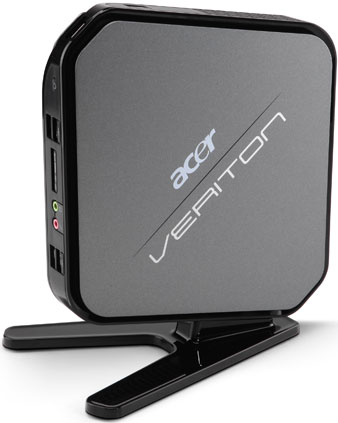
The Acer Veriton N282G
The Veriton N282G weighs about 2 lbs. With dimensions of 7.5 by 7.5 by 1.4 in., it’s about the size of a cigar box and looks huge next to the ViewSonic VOT125. Unlike the others, which are rectangular, it has an attractive diamond shape.
Its reserved gray-and-black color scheme is ready for the boardroom. A possible inconvenience is that the N282G’s external power adapter requires a three-prong grounded AC outlet.
The N282G comes ready to work with a full-size keyboard and a mouse, plus a desktop stand and mounting hardware so you can attach it to a monitor or under a desk. You need to line up the bracket’s mounting holes with those on the monitor before installation, which I found a little tricky. The PC can quickly be unclipped from its mounting bracket, which may make it a little too easy to steal.
What’s inside
With the ability to boot from a wired network, the Veriton N282G should easily fit into a corporate landscape, but like the others, it doesn’t have a TPM chip for network security. Getting inside the device to access all the major components is easily done by removing one screw and snapping the cover off.
The Veriton N282G has almost as many ports as a full-size PC, with six USB ports (two more than the others), along with VGA, HDMI and analog audio in/out connections. Its antediluvian RS-232 serial port is actually a bonus for businesses that use older hardware such as serial bar-code scanners. The Veriton N282G has a flash card reader as well as Ethernet and 802.11b/g/n Wi-Fi networking, but it lacks Bluetooth. It also lacks the digital audio connection of the Lenovo Q150.
Like the Lenovo and ViewSonic systems, the Veriton is limited by its maximum of 2GB of RAM. It has an Nvidia Ion GPU and a 1.8-GHz dual-core Intel Atom D525 CPU, which is midway between the processors found in the Lenovo and ViewSonic PCs. It comes with a 320GB hard drive. There’s also a lower-end model, the N281G, that’s about $50 cheaper; it comes with an Atom D425 processor and Intel GMA 3150 graphics.
Performance and power
With a score of 342.2 on the PassMark PerformanceTest 7 suite of benchmarking tests, the N282G was 20 per cent slower than the ViewSonic VOT125 but only 7 per cent off the pace of the Lenovo Q150 system. Still, the system’s Nvidia graphics card offered smooth and detailed high-definition video.
The N282G tied the Lenovo Q150 with a power consumption rating of 28 watts while in use. That adds up to about $8.50 a year in electricity costs, assuming it’s used for 10 hours per workday. In contrast, the ViewSonic VOT125 used significantly less power — 23 watts — while outperforming the others in the benchmark tests.
Upgrading the one-year warranty to a more realistic three years of coverage costs $49, a bargain compared to the others.
The system comes with Windows 7 Professional and Acer’s Veriton Control Center, a program that lets a user or an IT administrator make key adjustments to its power settings and boot-up routine or lock the machine if the wrong password is entered.
Bottom line
In the final analysis, while the Veriton N282G’s multitude of USB connections is seductive, its performance falls short of the mark.
Lenovo IdeaCentre Q150
At less than an inch thick, Lenovo’s IdeaCentre Q150 is the slimmest model in our roundup, but it lacks some expected features, such as a flash card reader.
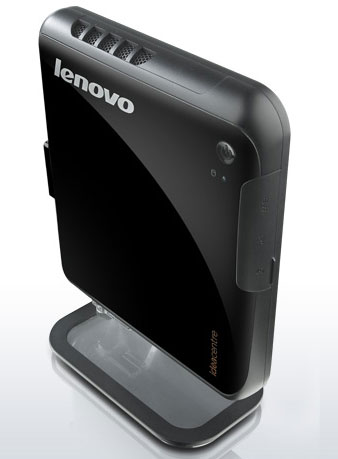
The Lenovo IdeaCentre Q150
Measuring 6.6 by 6.1 by 0.9 in., the Q150 is miniscule compared to the typical tower PC. It’s about the size of a mobile DVD drive and is so thin that it can be screwed to the underside of a desk without risking knocks from users’ knees. Its external power pack must be plugged into a three-prong AC outlet.
The Q150’s shiny black plastic case looks like an alien spaceship landing on your desk when it’s sitting on the included stand. There’s also a mounting bracket that doesn’t require tools to install. It’s hard to get your thumb and forefinger into the cramped space provided to tighten the hand screw that attaches it to a monitor or desk, but despite this, it only took about a minute to mount it.
The system comes with a wired mini keyboard and mouse that are too cramped and uncomfortable to be used for any significant length of time. A neat add-on option is Lenovo’s $60 Mini Wireless Keyboard. Looking something like a Star Trek phaser, it fits in one hand and has a trackball, multimedia controls and a QWERTY keypad. Don’t expect to type a long letter on it, but it’s perfect if you want to use the Q150 as a media machine in a lobby or conference room.
What’s inside
The Q150 can boot up from a network connection, but like the others, it doesn’t have a Trusted Platform Module chip for secure LAN connections. Getting inside the device to do maintenance or upgrades is challenging. It requires removing four tiny Phillips-head screws as well as hexagonal nuts on the end of the VGA port. Then you need to gently pry the lid off. It took me about 10 minutes, but I was rewarded with easy access to all the components; it’s much easier to deal with than the ViewSonic VOT125’s cramped interior.
The components are a mixed bag. On the plus side are Intel’s 1.66-GHz Atom D510 dual-core processor, a 500GB hard drive and Nvidia’s Ion graphics chip for full high-definition video. But like the others, the Q150 is limited to 2GB of RAM.
There’s a good assortment of ports, some of which are behind little doors. The basic model has four USB ports and connections for a VGA monitor and analog audio; the model I tested includes SPDIF and HDMI connectors for digital audio and HD video. The Q150 has Ethernet and 802.11b/g/n Wi-Fi wireless networking but does without Bluetooth and a flash card reader.
Performance and power
A midrange performer with a score of 366.4 on PassMark’s PerformanceTest 7.0, the Q150 I tested had a 7 per cent margin over Acer’s Veriton N282G, which uses slower memory chips. Its video quality was excellent, with smooth, sharp playback in high definition.
While operating, it consumed 28 watts of power, the same as the N282G and a little more than the ViewSonic model. This should amount to an annual power bill of about $8.50 for 10 hours of use each workday.
Along with Microsoft’s Windows 7 Home Premium, the Q150 is equipped with McAfee’s Security Center. It comes with a one-year warranty; increasing the coverage to a more sensible three years costs $135.
Bottom line
At $399, this superslim PC is an affordable and versatile option for many businesses.
ViewSonic VOT125
Easily one of the smallest PCs available anywhere, ViewSonic’s VOT125-04 delivers surprisingly good performance while sipping power. At $659, however, it is the most expensive of the three Windows machines I tested.
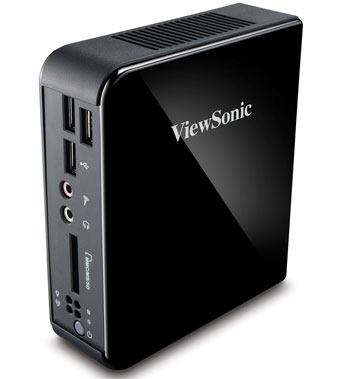
The ViewSonic VOT125
If you need to hide a PC in a tight spot, such as a trailer, small office or cramped Internet cafe, the VOT125 fits the bill. No bigger than a stack of four CD cases, it measures 4.5 by 5.1 by 1.5 in. — about one-fiftieth the size of a typical PC tower case.
On the downside, the system is so small that its cables can inadvertently pull it around or tip it over. It has an external AC adapter that requires a three-prong outlet.
Its shiny black plastic case should fit into just about any office décor, and the VOT125 comes with a slide-on desktop stand. It also has a metal mounting bracket; it took me less than a minute to screw it in place on my monitor and secure the PC to it. It’s much less awkward to install than the Acer model’s mounting bracket, but it does require a Phillips screwdriver.
What’s inside
Although it’s the only Windows machine in this roundup to ship without a keyboard and mouse, it’s also the only system of the group to include recovery discs for rebuilding a dead machine. Deploying the VOT125 in a business environment is eased by the system’s ability to boot from a wired network connection. Like the others, though, it doesn’t have a TPM chip for surefire authentication on a corporate network.
Getting inside the case requires loosening seven tiny screws. Once you’re in, it’s a tight fit. To get to the memory modules or the hard drive, you need to remove an aluminum plate, the heat sink and the fan.
Inside is a powerful PC with an ultra-low-voltage 1.3-GHz Intel Core 2 Duo processor, which is the most powerful chip in the group. It comes with 2GB of 800-MHz memory, a 250GB hard drive and integrated Intel GMA 4500M video. Like the Lenovo and Acer machines, it can hold only 2GB of system memory.
There is a good assortment of connectors, with four USB ports, an HDMI port, analog audio in/out ports and a flash card reader. While the unit has a DVI connection for an external monitor, it doesn’t come with an adapter to drive a VGA display, nor does it have a digital audio connector. On top of Gigabit Ethernet networking, the VOT125 has built-in 802.11b/g/n Wi-Fi, but lacks Bluetooth for connecting peripherals.
Performance and power use
Despite its diminutive size, the VOT125 delivers excellent performance. Its PassMark PerformanceTest 7 score of 418.1 was the best of the bunch, and it provided smooth, faultless video that made it hard to believe that the system was only the size of a paperback book.
Of the three, the VOT125 was the quietest with a barely audible fan, but it got hot — I measured a temperature of 130 degrees Fahrenheit at the exhaust vent on its top. The other units kept their cool much better; the closest was the Acer, which measured 115 degrees at its exhaust vent.
Even when it was doing heavy work, the system consumed only 23 watts of power, making it the low-power leader. Expect to spend roughly $7 a year in electricity for 10-hour workdays.
The VOT125 comes with Windows 7 Home Premium and a scant assortment of software, including Trend Micro’s Internet Security package. It has a one-year warranty; extending the system’s coverage to a more realistic three years adds $95.
Bottom line
With a suggested price of $659, the VOT125 is by far the most expensive of the Windows machines in the group, but it delivers a lot of power in a small, energy-efficient package.
How I tested
After measuring, weighing and examining the three Windows-based PCs and comparing major components and features, I set them up with a Hanns-G 17-inch monitor and the keyboard and mouse included with each PC. The ViewSonic VOT125 didn’t come with a keyboard and mouse, so I used an Adesso AKB-440UB, which has a built-in touchpad.
I used each system for several days over two months, doing typical business tasks: writing memos, working with e-mails, viewing and manipulating spreadsheets, and performing research on the Web.
This was followed by benchmarking each PC with PassMark’s PerformanceTest 7.0 suite. The program exercises every major component of the system and provides scores for individual areas, including processor, hard drive, 2D and 3D graphics and memory, as well as a single score that represents the system’s overall performance potential. I ran the software three times and averaged the results.
Then I measured how much power each system uses with a Kill A Watt PS power strip that shows electricity consumption. I used this figure to estimate how much it would cost to operate the system for a typical work year based on the Department of Energy’s latest average cost of 11.6 cents per kilowatt-hour of consumption. I assumed that each system would be used for 10 hours a day for 260 workdays a year.
I finished each individual examination by attaching the device first to the included stand and then using the included mounting hardware to attach it to the back of a monitor, paying attention to how hard it was to attach and how sturdy it was.
When the individual testing was finished, I connected all three systems to the Hanns-G monitor via a three-way VGA transfer switch box so that I could observe the video quality from all three PCs in rapid succession. I then watched several online HD videos as well as those stored on a local network server.
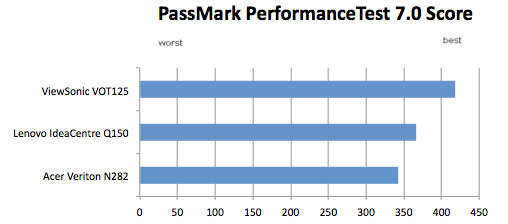
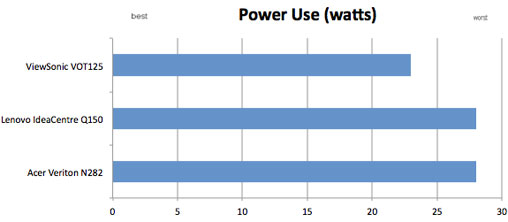
Test results: PassMark benchmarking and power use
Conclusions
After living and working with these tiny PCs for a couple of months, I’m convinced that they all do the basics well and could fit into most companies’ IT infrastructures fairly easily.
The tiny and powerful ViewSonic VOT125 is for those who have extremely limited space but need top performance, while the ultra-thin Lenovo IdeaCentre Q150 has a more moderate price tag and does just about everything well. Meanwhile, the Acer Veriton N282G is for workplaces that require lots of connections to USB gadgets and peripherals.
I know it’s a pipe dream, but I would love to have a computer that matches the ViewSonic VOT125’s diminutive size, excellent power use and performance with the Lenovo Q150’s enviably slim profile and the Veriton N282G’s assortment of ports. It would be small but perfect for all sorts of work and play.
Until that day comes along, my pick is Lenovo’s IdeaCentre Q150, which comes close in all respects, offering the best balance of price, performance and size — the best deal in tiny PCs I’ve seen.
Extra: Apple’s Mac Mini
The granddaddy of the consumer-oriented tiny PC crowd is Apple’s Mac Mini, which debuted in 2005. Apple has updated the model frequently since then; the most recent version came out in June of this year. It’s a small wonder that is equal parts performance and purposeful design, but at $700 it costs nearly twice what some other tiny computers go for.
Housed in a demure silver-and-black aluminum case, the Mini stands out, with sleek styling and rounded corners. Next to the Windows-based micro PCs in our roundup, the Mini’s industrial design really shines.
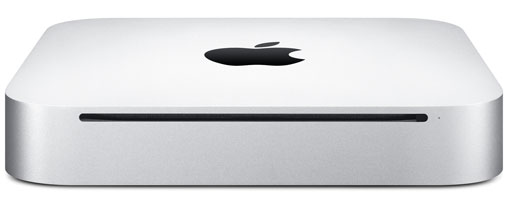
The Apple Mac Mini
On the other hand, the system is a mixed bag for IT administrators. It can’t boot from a network connection, and it lacks a Trusted Platform Module chip.
Access to the Mini’s innards is about as easy as it gets, with a round plastic hatch on the bottom that requires a slight twist to open. On the downside, the Mini has neither a stand nor mounting hardware. Brackets for the Mini are available from some third-party vendors, including Sonnet Technology, whose MacCuff mounting system costs $60, but Velcro tape also works just fine.
The Mini has something the Windows PCs in this roundup don’t: a DVD burner. It’s a slot-loading drive that does away with the cumbersome disc tray. Even with that extra hardware, the Mini measures only 7.7 by 7.7 by 1.4 in. — roughly twice the size of the ViewSonic VOT125 — and weighs 3 lbs. Like the VOT125, the Mini doesn’t include a keyboard or mouse in its starting price.
Earlier Mini models have been used in all sorts of business operations, including hotels, cruise ships and airports. In just about all areas, the new Mini is an improvement. The entry-level $700 unit I looked at comes with a 2.4-GHz Intel Core 2 Duo processor, 2GB of RAM and a 320GB hard drive. You can upgrade to a faster processor, a larger hard drive and up to 8GB of system memory; there’s also a high-end (but still small) server model that starts at $1,000.
Graphics are handled by the Mini’s Nvidia’s GeForce 320M imaging engine, which produced smooth and vivid video on my 20-in. Apple Cinema display. The Mini connects to a monitor through its Mini DisplayPort, which supports up to 2560×1600-pixel resolution, or its HDMI connection, which tops out at 1920×1200-pixel resolution. For those wanting to use an older monitor, the system comes with an adapter that converts the video signal into a DVI connection, but an adapter for a VGA monitor costs $30.
The rest of the Mini is a mix of old and new, with four USB, one FireWire 800 and audio in/out ports. Those who use digital cameras will be glad to see a flash card reader that works with SD cards, and it’s got communications covered with Ethernet and 802.11a/b/g/n Wi-Fi networking as well as the bonus of Bluetooth.
PassMark’s benchmarking software doesn’t run on Apple’s Mac OS X, but the Mini acquitted itself well when I used it for typical office tasks like e-mail, Web research and writing. Its cursor response was crisp and the video excellent, with smooth HD playback and only occasional slowdowns when I was simultaneously e-mailing, surfing the Web and playing HD video.
While running, the Mini consumes 24 watts, a smidgen more than the ViewSonic system, for an estimated annual power bill of about $7.
Apple provides a lot of software with the Mini, mostly oriented around fun and games; my favorite is GarageBand for creating podcasts or audio CDs. While the Mini comes with the standard one-year warranty, Apple’s support technicians will talk to you for free on the phone for only 90 days, a big disappointment. Extending coverage to a more practical three years is a relatively expensive $149 option.
The Mini is a small computer that packs a wallop. Too bad its price tag is too big for many companies to swallow.
Brian Nadel is a frequent contributor to Computerworld and the former editor in chief of Mobile Computing & Communications magazine.




